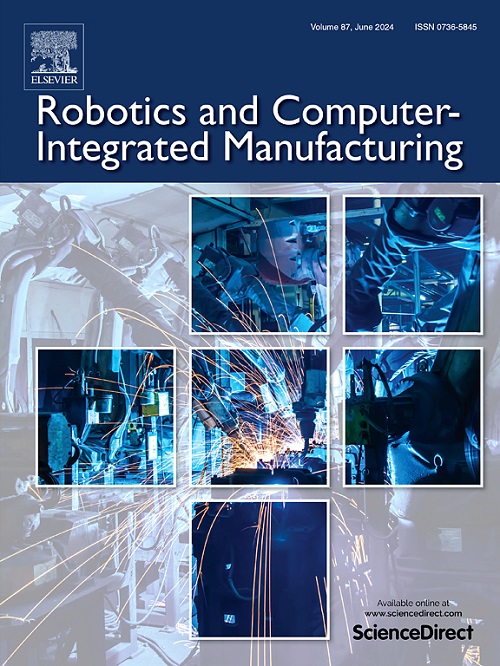Large and small-scale models’ fusion-driven proactive robotic manipulation control for human-robot collaborative assembly in industry 5.0
IF 11.4
1区 计算机科学
Q1 COMPUTER SCIENCE, INTERDISCIPLINARY APPLICATIONS
引用次数: 0
Abstract
Human-robot collaborative (HRC) assembly has been popular by combining human creativity and dexterity with robotic precision for higher assembly efficiency and resilience in industry 5.0. Nevertheless, current HRC assembly systems rely predefined codes, limiting robot adaptability to dynamic and unstructured assembly environments. To bridge the gap, this paper proposes a novel proactive robotic manipulation control method for HRC assembly, which fully utilizes large-scale model (LSM) in cognitive computing and reasoning for dynamic robotic control path planning, and small-scale models (SSMs) in efficiently computing for dynamic robotic control demand perception and control constraints verification. Specifically, LSM, namely ChatGPT 4o, is deployed on the cloud to proactively generate robotic control constraints according to the robotic control demand derived from SSMs on the edge. Here, two kinds of SSMs are developed, including robotic control demands perception model and robotic control constraints verification model. For robotic control demands perception, an ensemble encoder model is proposed for ongoing human assembly action detection, on which a vision model and fine-tuned assembly instruction generation model are designed for assembly manipulation keypoints image and robot control instruction generation, serving as the input for LSM. For robotic control constraints verification, a digital twin model is used to verify the control constraints derived from LSM, where verified constraints are used for robotic control during assembly process. Finally, the feasibility and effectiveness of the proposed approach are demonstrated through experiments on an HRC assembly process, where over 99 % accuracy for human assembly action detection and 80 % task execution accuracy are conducted.
面向工业5.0人机协同装配的大、小模型融合驱动主动机器人操作控制
在工业5.0中,人机协作装配(HRC)将人类的创造力和灵巧性与机器人的精度相结合,以实现更高的装配效率和弹性。然而,目前的HRC装配系统依赖于预定义的代码,限制了机器人对动态和非结构化装配环境的适应性。为了弥补这一差距,本文提出了一种新的HRC装配机器人主动操作控制方法,该方法充分利用大尺度模型(LSM)进行动态机器人控制路径规划的认知计算和推理,以及小尺度模型(SSMs)进行动态机器人控制需求感知和控制约束验证的高效计算。具体而言,部署在云端的LSM即ChatGPT 40,根据边缘ssm导出的机器人控制需求,主动生成机器人控制约束。本文提出了机器人控制需求感知模型和机器人控制约束验证模型。针对机器人控制需求感知,提出了用于人体装配动作检测的集成编码器模型,并在此基础上设计了用于装配操作关键点图像和机器人控制指令生成的视觉模型和微调装配指令生成模型,作为LSM的输入。对于机器人控制约束的验证,采用数字孪生模型对LSM导出的控制约束进行验证,验证后的约束用于机器人装配过程的控制。最后,通过HRC装配过程的实验验证了该方法的可行性和有效性,在该过程中,人类装配动作检测的准确率超过99%,任务执行的准确率超过80%。
本文章由计算机程序翻译,如有差异,请以英文原文为准。
求助全文
约1分钟内获得全文
求助全文
来源期刊
CiteScore
24.10
自引率
13.50%
发文量
160
审稿时长
50 days
期刊介绍:
The journal, Robotics and Computer-Integrated Manufacturing, focuses on sharing research applications that contribute to the development of new or enhanced robotics, manufacturing technologies, and innovative manufacturing strategies that are relevant to industry. Papers that combine theory and experimental validation are preferred, while review papers on current robotics and manufacturing issues are also considered. However, papers on traditional machining processes, modeling and simulation, supply chain management, and resource optimization are generally not within the scope of the journal, as there are more appropriate journals for these topics. Similarly, papers that are overly theoretical or mathematical will be directed to other suitable journals. The journal welcomes original papers in areas such as industrial robotics, human-robot collaboration in manufacturing, cloud-based manufacturing, cyber-physical production systems, big data analytics in manufacturing, smart mechatronics, machine learning, adaptive and sustainable manufacturing, and other fields involving unique manufacturing technologies.

 求助内容:
求助内容: 应助结果提醒方式:
应助结果提醒方式:


